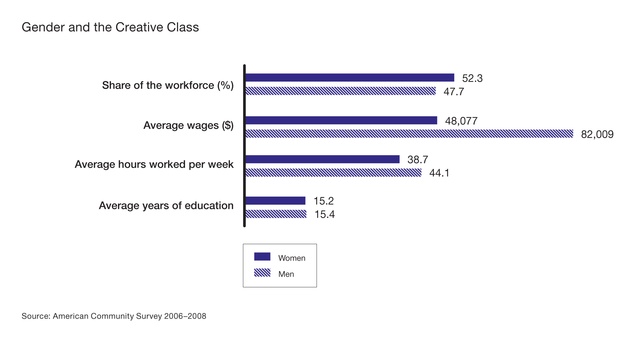Today in news you already knew: men earn more than women. This latest study, which focuses on the “creative class,” discovered that men in this group make 70 percent more than women who work in similar jobs. The creative class consists of jobs in architecture and engineering, arts and entertainment, business and finance, computers and math, education, healthcare, law, physical and social sciences, and management. These jobs are more lucrative and recession-proof than other jobs, and make up nearly a third of the workforce.
 Though women hold a slight majority of creative jobs and have roughly the same education level as men, they earn significantly less. When controlling for education and hours worked, the $33,932 income gap shrinks to $23,700, which still puts men’s wages 49.2 percent higher than women’s. The inequality becomes more pronounced in fields where women hold a majority of the jobs, like healthcare, while the opposite is true of male-dominated professions.
Though women hold a slight majority of creative jobs and have roughly the same education level as men, they earn significantly less. When controlling for education and hours worked, the $33,932 income gap shrinks to $23,700, which still puts men’s wages 49.2 percent higher than women’s. The inequality becomes more pronounced in fields where women hold a majority of the jobs, like healthcare, while the opposite is true of male-dominated professions.
All this noise is both good and bad for women in the workplace. While it does reveal the ugly truth of gender inequality, studies like this can pave the way for work that needs to be done. I’m sure I’m not the only feminist who is torn between feelings of vindication that feminism is just as relevant as ever and concern. How is it possible that there’s still so much work to be done?
Rehashing the statistics might feel like we’re beating a dead horse. But what happens when we look at the trends behind the numbers? Some social commentators believe that the modern workplace is becoming feminized, and have declared it a hostile environment for men. It’s true that women now outnumber men on university campuses and in the workforce, but to describe the skills valued in the knowledge economy as “feminine” is absurd. Cooperation, creative thinking, and effective communication weren’t imported into the office by women hoping to feel more warm and fuzzy at work, they’re skills that help everyone thrive in a diverse environment. And there’s no guarantee whatsoever that a woman in the workplace might get ahead for displaying these characteristics, no matter how useful they turn out to be.
Jobs in the creative class require so-called “feminine” skills moreso than any other field, so why are women earning so much less? Other researchers have suggested that homosociality reproduces inequality. Men are mentored and promoted into higher paying jobs by other men who they’ve gotten to know at casually. Gender norms also affect wages even when individuals themselves don’t conform to expectations. Employers have been known to overlook women for promotion to avoid investing in an employee who may eventually leave her job to raise a family. This biologically-based line of thinking imposes limits on men and women who could otherwise make their own choices about how to structure their family (or lack of family) life. Finally, the fact that jobs dominated by women have the largest income gap might JUST MAYBE mean that women’s work continues to be undervalued.
As someone who recently joined the creative class, I’m not exactly ecstatic. As a lesbian, I’m even more bummed out. If, at some point, I decide to get married to someone who also works in a creative job, the sum of our incomes is projected to be only a little more than that of a single man. One positive outcome of economic inequality is that it puts hard data to claims minorities have been making for years. It becomes more difficult to suggest that women or people of color simply aren’t working hard enough when academic research paints a picture of discrimination. So tell your dad, your neighbors, and your dog: you’re not making this ish up.




Great post! I just had to defend feminism to a class full of college students who believed that the movement was no longer relevant, because women have the same legal rights as men. I was very surprised (and disappointed) to see so many young women who were not only passive in the conversation, but who felt that they needed to say “I’m not a crazy feminist,” in order to get approval from their peers.
It shouldn’t be wrong to point out areas of discrimination, especially if there is evidence to support it. Salary equality is one major area where America still needs LOTS of improvement, which this study proves.
As a woman who’s been working in engineering/technical fields for 30 years, I have a message for the young women in your college classes. If they think they will be entering a work world of equality of opportunity/treatment/pay, they have a big surprise coming.
“Even when we control for education, skills, and hours worked, men out-earn women by $10,600 overall and by $23,700 in Creative Class jobs.”
$10,000 to nearly $24,000 A YEAR??! That is insane. Women make up 47% of the workforce–more, in certain fields. This report doesn’t even begin to delve into racial differences, either, but you can bet your bottom-and-worth-less-than-male-colleagues’ dollar that the wage gap is even wider for black and Latina women.
Just another reason why I am a feminist, and proud to call myself one. This shit is not okay.
My partner works in IT, and one day she accidentally saw what wages everyone in her department were making. She was shocked and appalled – and one of the things that was said in that study is that the wage gap isn’t as bad in male-dominated fields! (Which isn’t to say it couldn’t have been worse at her employer.)
It both shocks me and doesn’t surprise me at the same time. Which is a weird feeling.
See. This is why unions are good.
Great post! It needs a more intersectional analysis, though. The 70% stat is always shocking, but women of colour, indigenous women, and immigrant women all make significantly less than white women. If we’re going to have a conversation about women in the work force, it’s necessary to consider exactly who we’re talking about.
http://criaw-icref.ca/WomenAndPoverty
intersectionality definitely definitely needs to be talked about! i was trying to keep this short and sweet, so I’m glad you brought it to the table.
“Men are mentored and promoted into higher paying jobs by other men who they’ve gotten to know at casually. “
yes, i was just talking about this this week!!!!
anyhow yes from my experience these stats seem absolutely true. Hopefully one day we can change them. Great post Laura!
Pingback: Latest Workplace Communication News | Dept Relief Today
Extremely shocking. . .Wait, no I take it back. Not shocking, just confirming. I think I need to start charging more. lol.
I wanna be an engineer. This is…. fucking scary. I mean, I’ve been a bit of a douche bragging about how MY JOB gets a great pay and security. But oh wait, I’m a half-latina girl. So, no. Not great pay.
Also, I would like to to highlight this whole article and then send it to my dad as a rebuttal to his claim that “affirmative action” gives women/minorities an unfair advantage.
I am a fine artist for a living. My work is actually based in my masters degree in mental health counseling with a focus on women’s issues and the art is meant to deal with many of the issues women have with body image and self worth.
I have to say, not even my degree seems to do anything for the perceived value of my artistic work. I am very well connected in the local art scene and time and time again my prices are criticized where as those of my male colleagues are seen as absolutely justified: despite the fact that my work took just as long to create.
I have found that women artists are far more likely to ask for less for their work than men. They are also much more likely to have their customers try to negotiate down their already lower prices. Its a sad truth.
—-({*})—-
For Women.
For the Love of Women.
http://www.VulvaLoveLovely.com
Pingback: Making Sense of the “78 Cents to a Man’s Dollar” Wage Gap – Lipstick & Politics